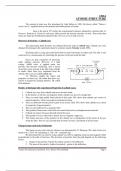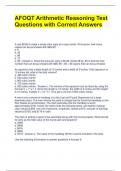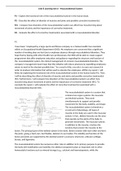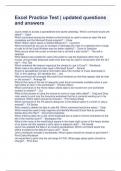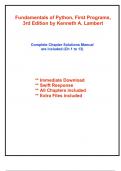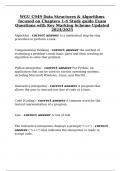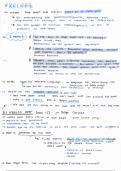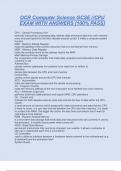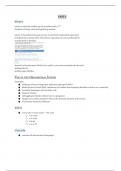ATOMIC STRUCTURE
The concept of atom was first introduced by John Dalton in 1808. His theory called “Dalton’s
atomic theory” regarded atom as the smallest indivisible particle of matter.
Later at the end of 19th century the experimental evidences obtained by scientists like J.J
Thomson, Rutherford, Chadwick and many others proved the internal structure of atom. They found that
atoms are made up of fundamental particles like electrons, protons and neutrons.
Discovery of electrons – Cathode rays
The information about electrons was obtained from the study of cathode rays. Cathode rays were
obtained by discharge tube experiments done by scientists mainly Faraday in mid 1850s.
Discharge tube is a long glass tube fitted with two metal electrodes on either ends. The tube is also
connected to a vacuum pump for controlling the pressure of the gas inside the tube.
Gases are poor conductors of electricity
under ordinary pressure. However, if a high
voltage (10000 volts) is applied under low
pressure, they become conducting. Also a stream
of particles starts moving in the tube from cathode
to anode. Since these rays originated from the
cathode, these rays are called cathode rays.
J.J. Thomson studied the nature and
properties of these rays. He found that these rays
consist of negatively charged particles. He called
them electrons.
Results of discharge tube experiment [Properties of cathode rays].
1. Cathode rays start from cathode and move towards anode.
2. In the absence of electric and magnetic fields, cathode rays travel in straight line.
3. They can rotate light paddle wheel placed in their path. This shows that cathode rays consist of
material particles, which can produce mechanical motion.
4. They are deflected towards positive plate in an electric field. This shows that cathode rays consist
of negatively charged particles.
5. They are also deflected in a magnetic field.
6. They produce fluorescence when falls on certain fluorescent or phosphorescent materials.
7. Cathode ray ionizes the gases through which they pass.
8. They produce X-rays when fall on metals such as tungsten, copper etc.
9. The charge and mass of the particles in the cathode ray is independent of the nature of the gas
inside the tube. Thus we can conclude that electrons are basic constituent of all the atoms.
Charge to mass ratio (e/m) of electrons
The charge to mass (e/m) ratio for electron was determined by J.J Thomson. The value of e/m was
found to be 1.758 x 108 coulombs/g (1.758 x 1011 coulombs /kg)
He determined the e/m ratio by using cathode ray tube by applying electrical and magnetic fields
perpendicular to the path of electrons. The deviation of particles from the path depends on the following
factors.
1. Charge on the particle: Greater the charge, greater is the deflection.
2. The mass of the particle: Lighter the particle , greater is the deflection.
Tuition For Chemistry, Kochulloor, Tvm. Phone: 0471 2550382 Page 1
, 3. The strength of electric or magnetic field: Higher the strength, greater is the deflection.
When only electric field is applied electron deviate
from the path and strikes at the point A. Similarly when
magnetic field is applied, electron strike at point C. By carefully
balancing electric and magnetic fields, it is possible to bring
back the electrons at point B
From the careful measurement of the amount of
deflection and strength of electric field and magnetic field, it is
possible to calculate e/m ratio of an electron
Charge of the electron
The charge of the electron was determined by R.A. Millikan in 1909 by “ oil drop experiment”.
The charge was found to be 1.6 x 10-19 C. This is taken as one unit negative charge.
Millikan’s oil drop experiment
In this method, tiny oil drops produced by an atomizer is
allowed to fall through a tiny hole in the upper plate of electrical
condenser. These droplets are then viewed through a telescope.
From the rate of fall it is possible to calculate the mass of oil
drops. Then the air inside the chamber is ionized by passing a
beam of X-rays. Then the oil drops gain charge on their surface.
As a result the fall of these droplets can be retarded, accelerated
or made stationary depending on the charge. By carefully
measuring the effects of electrical field strength on the motion of
oil drops, it is possible to calculate the magnitude of electrical
charge on the drop. Millikan found that the charge is always an
integral multiple of 1.6 x 10-19 C. So he concluded that charge of
an electron is 1.6 x 10-19 C.
Mass of electron
By combining the e/m ratio and charge (e) of the electron, it is possible to calculate mass of the
electron.
Thomson experiment: e/m = 1.758 x 108 C/g
Millikan experiment : e = 1.6 x 10-19 C
e 1.6 x1019 C
Mass of the electron, m = = = 9.1 x 10-28g (9.1 x 10-31kg )
e/m 1.758x108 c / g
Thus electron is a fundamental particle of atom carrying one unit negative charge and having mass nearly
equal to 1/1837th of mass of an atom hydrogen.
Anode rays [ Canal rays]
Goldstain discovered the existence of a new
types of rays in the discharge tube. He used a
perforated cathode in the discharge tube. On applying
electric field at low pressure, he observed a new type
of rays behind the cathode. These rays are called
anode rays or canal rays.
Tuition For Chemistry, Kochulloor, Tvm. Phone: 0471 2550382 Page 2
, Properties of anode rays.
1. Unlike cathode rays, the positively charged particles depend upon the nature of the gas present in
the discharge tube. They are simply the positively charged gaseous ions.
2. The charge to mass ratio of the particles in the anode rays depends upon nature of the gas taken in
the discharge tube.
3. Some positively charged particles carry a multiple of the fundamental unit electrical charge.
4. They are deflected towards negatively charged plate in an electric field. They are also deflected in
a magnetic field.
Origin of cathode rays and anode rays
Under the influence of high potential difference, the gas in the discharge tube is ionized. The
negatively charged particles produced (electrons) move towards anode as cathode rays. On their way they
collide with the atoms of the gas producing more electrons and positively charged particles. The positive
ions move towards cathode in the form of anode rays.
Discovery of proton
The charge to mass ratio of particles in the anode rays depend upon the nature of the gas in the
discharge tube. The e/m ratio was maximum when hydrogen gas taken in the tube. This means that the
positive particles formed from hydrogen are the lightest. These lightest positively charged particles were
named as protons.
The charge to mass ratio for proton = 9.58 x 104 C/g
Charge of the proton = 1.6 x 10-19 C
Mass of the proton = 1.673 x 10-24 g (1.673 x 10-27 kg)
The proton is the fundamental particle of atom carrying one unit positive charge and having mass equal to
the mass of one hydrogen atom. [Mass of proton = 1837 times the mass of an electron.]
Discovery of neutron
Neutrons were discovered by James Chadwick in 1932. He bombarded a thin film of beryllium
with α-particles. Then he observed that highly penetrating rays consisting of neutral particles were
produced.
4Be + 2He → 6C
9 4 12
+ 0n1
These neutral particles were named neutrons.
The mass of neutrons = 1.675 x 10-27 kg
They are present in all atoms except hydrogen.
Name Discoverer Symbol Absolute Relative Mass(Kg) Mass(amu) Aprox.mass
charge charge (amu)
Electron J.J.Thomson e -1.6 x 10-19 C -1 9.1 x 10-31 0.00054 0
Proton Goldstain p 1.6 x 10-19 C +1 1.673x 10-27 1.007 1
Neutron Chadwick n 0 0 1.675x10-27 1.008 1
EARLIER ATOMIC MODELS
1. Thomsons model of atom
J.J.Thomson in 1898 proposed the first atom model. He
proposed that an atom consists a uniform sphere of
positive electricity (radius= 10-10 m) in which electrons
are distributed more or less uniformly. In this model,
atom is visualized as a pudding or cake of positive charge
with raisins (electrons) embedded into it. Therefore this
Tuition For Chemistry, Kochulloor, Tvm. Phone: 0471 2550382 Page 3

